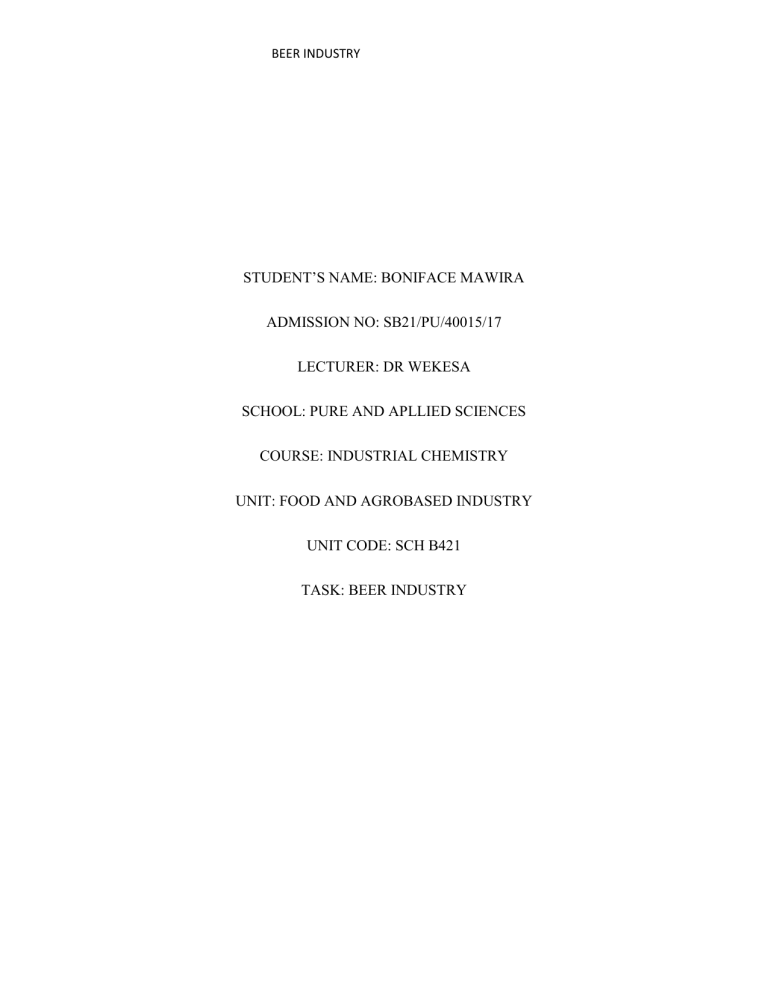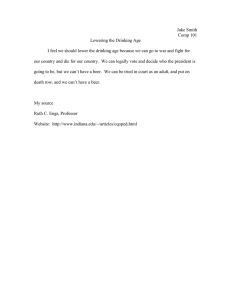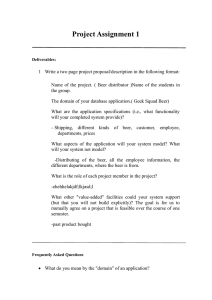
BEER INDUSTRY STUDENT’S NAME: BONIFACE MAWIRA ADMISSION NO: SB21/PU/40015/17 LECTURER: DR WEKESA SCHOOL: PURE AND APLLIED SCIENCES COURSE: INDUSTRIAL CHEMISTRY UNIT: FOOD AND AGROBASED INDUSTRY UNIT CODE: SCH B421 TASK: BEER INDUSTRY BEER INDUSTRY INTRODUCTION Beer is one of the oldest and most widely consumed alcoholic drink in the world, and the third most popular drink overall after water and tea. Beer is brewed from cereal grain, most commonly from malted barley, though wheat, maize corn, and rice are also used. During the brewing process, fermentation of the starch sugars in the wort produces ethanol and carbonation in the resulting beer. Most modern beer is brewed with hops which add bitterness and other flavors and act as a natural preservative and stabilizing agent. Other flavoring agents such as gruit, herbs, or fruits may be included or used instead of hops. In commercial brewing, the natural carbonation effect is often removed during processing and replaced with forced carbonation. Beer is distributed in bottles and cans and is also commonly available on draught, particularly in pubs and bars. The brewing industry is a global business, consisting of several dominant multinational companies and many thousands of smaller producers ranging from brewpubs to regional breweries. The strength of modern beer is usually around 4% to 6% alcohol by volume, although it may vary between 0.5% and 20%, with some breweries creating examples of 40% alcohol volume and above BREWING The process of making beer is known as brewing. A dedicated building for the making of beer is called a brewery, though beer can be made in the home and has been for much of its history. A company that makes beer is called either a brewery or a brewing company. Beer made on a domestic scale for non-commercial reasons is classified as home brewing regardless of where it BEER INDUSTRY is made, though most homebrewed beer is made in the home. Brewing beer is subject to legislation and taxation in developed countries. The purpose of brewing is to convert the starch source into a sugary liquid called wort and to convert the wort into the alcoholic drink in a fermentation process effected by yeast. The first step, is where the wort is prepared by mixing the starch source normally malted barley with hot water. Hot water is mixed with crushed malt in a mash tank. The mashing process takes around 1 to 2 hours during which the starches are converted to sugars, and then the sweet wort is drained off the grains. The grains are now washed in a process known as sparging. This washing allows the brewer to gather as much of the fermentable liquid from the grains as possible. The process of filtering the spent grain from the wort and sparge water is called wort separation. The traditional process for wort separation is lautering, in which the grain bed itself serves as the filter medium. Some modern breweries prefer the use of filter frames which allow a more finely ground grist. Most modern breweries use a continuous sparge, collecting the original wort and the sparge water together. However, it is possible to collect a second or even third wash with the not quite spent grains as separate batches. Each run would produce a weaker wort and thus a weaker beer. This process is known as second running and Brewing with several runnings is called parti gyle brewing. The sweet wort collected from sparging is put into a kettle and boiled, usually for about one hour. During boiling, water in the wort evaporates, but the sugars and other components of the wort remain; this allows more efficient use of the starch sources in the beer. Boiling also destroys any remaining enzymes left over from the mashing stage. Hops are added during boiling as a source of bitterness, flavor and aroma. Hops may be added at more than one point during the BEER INDUSTRY boil. The longer the hops are boiled, the more bitterness they contribute, but the less hop flavor and aroma remains in the beer. After boiling, the hopped wort is now cooled, ready for the yeast. In some breweries, the hopped wort may pass through a hop back, which is a small vat filled with hops, to add aromatic hop flavoring and to act as a filter; but usually the hopped wort is simply cooled for the fermenter, where the yeast is added. During fermentation, the wort becomes beer in a process that requires a week to months depending on the type of yeast and strength of the beer. In addition to producing ethanol, fine particulate matter suspended in the wort settles during fermentation. Once fermentation is complete, the yeast also settles, leaving the beer clear. During fermentation most of the carbon dioxide is allowed to escape through a trap and the beer is left with carbonation of only about one atmosphere of pressure. The carbonation is often increased either by transferring the beer to a pressure vessel such as a keg and introducing pressurized carbon dioxide, or by transferring it before the fermentation is finished so that carbon dioxide pressure builds up inside the container as the fermentation finishes. Sometimes the beer is put unfiltered into bottles with some added sugar, which then produces the desired amount of carbon dioxide inside the bottle. BEER INGREDIENTS The basic ingredients of beer are water; a starch source, such as malted barley, able to be converted to sugars then fermented. A mixture of starch sources may be used, with a secondary carbohydrate source, such as maize, rice, wheat, or sugar, often being termed an adjunct, especially when used alongside malted barley. Less widely used starch sources BEER INDUSTRY include millet, sorghum and cassava root in Africa, and potato in Brazil, and agave in Mexico, among others. The amount of each starch source in a beer recipe is collectively called the grain bill. Flavoring beer is the sole major commercial use of hops. The flower of the hop vine is used as a flavoring and preservative agent in nearly all beer made today VARIETIES While there are many types of beer brewed, the basics of brewing beer are shared across national and cultural boundaries. The widely known beer varieties include Real ale, Pale ale, stout and porter, Mild ale, Lambic. MEASUREMENT AND COLOUR Beer is measured and assessed by bitterness, by strength and by color. The perceived bitterness is measured by the International Bitterness Units scale (IBU). Beer color is determined by the malt. The most common color is a pale amber produced from using pale malts. Pale lager and pale ale are terms used for beers made from malt dried with the fuel coke. HEALTH EFFECT Beer contains ethanol, an alcohol, which has short and long-term effects on the user when consumed. Different concentrations of alcohol in the human body have different effects on a person. The effects of alcohol depend on the amount an individual has drunk, the percentage of BEER INDUSTRY alcohol in the beer and the timespan over which the consumption has taken place, the amount of food eaten and whether an individual has taken other prescription, over-the-counter or street drugs, among other factors. Drinking enough to cause a blood alcohol concentration of 0.03%– 0.12% typically causes an overall improvement in mood and possible euphoria, increased selfconfidence and sociability, decreased anxiety, a flushed, red appearance in the face, impaired judgement and fine muscle coordination. A BAC of 0.09% to 0.25% causes lethargy, sedation, balance problems and blurred vision. A BAC from 0.18% to 0.30% causes profound confusion, impaired speech (e.g., slurred speech), staggering, dizziness and vomiting. A BAC from 0.25% to 0.40% causes stupor, unconsciousness, anterograde amnesia and vomiting. Therefore, one is required to take beer responsibly to avoid this complication. REFERENCES Clemons, E. K., Gao, G. G., & Hitt, L. M. (2006). When online reviews meet hyperdifferentiation: A study of the craft beer industry. Journal of management information systems, 23(2), 149-171. Ambrosi, A., Cardozo, N. S. M., & Tessaro, I. C. (2014). Membrane separation processes for the beer industry: A review and state of the art. Food and bioprocess technology, 7(4), 921-936.

